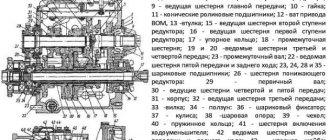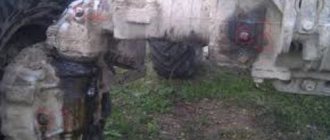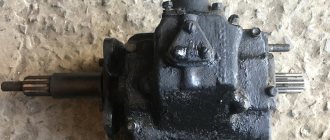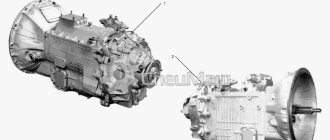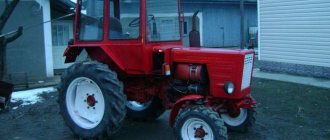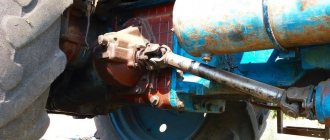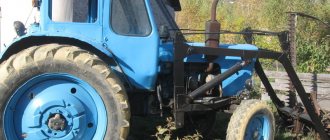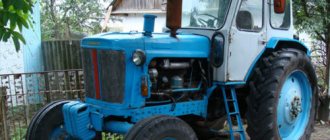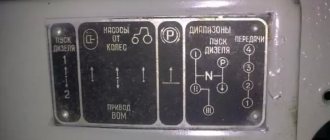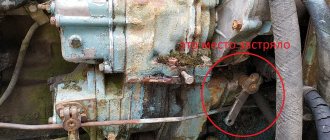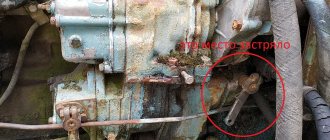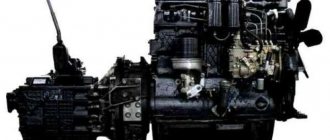The MTZ-82 gearbox is designed primarily for various operating modes of the machine. Thanks to their presence, equipment manufactured at the Minsk Tractor Plant is capable of performing various types of actions while using a minimum amount of fuel. The gearbox on the MTZ-80, like the MTZ-82 gearbox, operates on the same principles, which makes it possible to study them together. This list can also include the MTZ-50 gearbox, the structure of which is similar. But the design of the gearbox of the newer MTZ-82.1, 80.1, 82.2 will already have some differences.
Transmission MTZ-80, its structure and diagram
Let's look at what mechanisms make up the transmission of the Belarus MTZ-80 tractor with rear wheel drive.
- The clutch is single-disc, equipped with a brake for the driven shaft, which facilitates the process of gear shifting.
- Two-stage reduction gearbox that doubles the number of gears.
- Two-stage rear PTO drive gearbox – has fixed speeds of 540 and 1000 rpm.
- Manual transmission – eleven-speed: 9 forward and 2 reverse gears.
- Speed reducer - ensures forward travel at a speed of 0.27-0.6 km/h (only in 1st and 2nd gears) and backward movement at a speed of 0.6-1.3 km/h.
- Rear axle - consists of gears of the main drive, differential and two side gears.
The picture shows a diagram of the transmission structure of the MTZ-80 tractor.
Crankcase and supercharger
The MTZ-82 gear shift scheme uses an oil sump (sump) with a volume of 15 liters. It is equipped with two gears, has a durable support platform with spacers and connecting cups in the side segments. They are equipped with bushings that act as seals and prevent oil from escaping. During operation, the bushings wear out and must be periodically replaced.
The pumping mechanism consists of a set of disks, between which rigid gaskets are installed. The stands on which the device is mounted are equipped with small protrusions, and the lower support element is rigidly attached.
The injection mechanism operates in difficult conditions and requires periodic maintenance. It is necessary to regularly remove sediment present in the oil and small metal particles that appear during the friction of moving elements.
Diagram of the MTZ-80 old-style gearbox
Let us consider in detail the transmission diagram of the Belarus MTZ-80 tractor of the old model (with a small cabin). The gearbox is a unit made in the form of a 2-speed, 4-shaft gearbox with gears, which is placed in a cast iron crankcase. In the transmission system, it is located between the rear axle and a two-stage reduction gearbox coupled with the clutch. The parallel shafts rest on bearings that are mounted into the walls and partition of the cast iron housing. The gears are attached to the shafts using splines, and some rotate freely.
General information
The MTZ-82 gear shift scheme is based on the design of the gearbox and the features of its composition. The box is a set of gears, connected in different combinations and providing different gear ratios, installed in the crankcase with a pressure mechanism. Increasing the gear ratio increases speed, decreasing it increases power.
Transmission MTZ-82 cross-section with description
Diagrams of the MTZ-82 tractor gearbox in longitudinal and transverse sections with a detailed description allow you to understand its structure in detail.
Let's consider the main elements of the mechanism:
- gear shafts;
- intermediate shaft;
- creeper;
- driving and driven, gears;
- idler gear;
- two-stage reduction gearbox;
- ball bearings;
- unit housing with two hatches in which, instead of covers, they can be installed: on the left - a side power take-off shaft or creeper, and on the right - a transfer case.
Pneumatic system control
The main task of the air equipment is to provide a pneumatic drive for the braking system of vehicles towed by a tractor. In addition, compressed air is used to service equipment, such as inflating tires , blowing filters and radiator screens.
To preserve service life, the compressor only when it is necessary to drive the brakes. Activation is carried out by a lever that engages the drive gear with the intermediate gear of the diesel fuel pump (HPF) drive.
How the MTZ-82 gearbox works
Belarus tractors are equipped with an eleven-speed gearbox. Thus, the equipment has 9 front and 2 rear operating modes. It is worth considering that when the basic configuration of the tractor includes the inclusion of a creeper gearbox, the number of operating modes will automatically double. This scheme will serve optimally if the tractor operates in difficult areas: it will significantly expand the capabilities of the unit without increasing fuel consumption.
The switching diagram and gearbox design can be found freely available on the Internet without any problems. Let's look at how the gearbox is structured, how we disassemble, dismantle and assemble the devices included in the set of the repaired gearbox of Belarus wheeled tractors.
Gearbox diagram and principles of its operation:
- Gears can only be changed at low engine speeds.
- At this stage you need to press the clutch.
- Switching on the required operating mode, the clutch can be released, but this must be done smoothly.
Sometimes an incident can happen: the gearbox will jam and it will be impossible to change gears. To get rid of this, you need to return the switch to its original position and repeat all the steps from the very beginning.
Let's look at how gearboxes are designed, which will make it possible, if necessary, to assemble these devices or dismantle them. The MTZ-80 gearbox not only allows you to change speeds, but is also responsible for the proper operation of the equipment that is mounted on top of the tractor. For this purpose, the machine has a power take-off shaft, which is installed on the side.
Let's look at how the MTZ-80 transfer case works and repair the MTZ gearbox. 82 gearbox assembly, repair, disassembly and gear shifting will also be covered. The gearbox contains 4 shafts in pairs, parallel to each other. The primary and secondary shafts are mounted into the device on a single axis, and they are united by support bearings.
The input shaft is equipped with gears responsible for third, fourth and fifth gears, interconnected by a splined connection. Thanks to the gear, design engineers connected the input shaft to the creeper gearbox. A part is mounted on the middle shaft, which, with its teeth, connects to a gear part that regulates the engagement of the third speed gear.
The intermediate shaft is driven using a special-purpose bushing, which is mounted in the bearing race. It is engaged with the gear responsible for the second stage of the gearbox transfer case - it is often called the central one. Behind this gear, engineers placed the power take-off cams. A system is installed above it that allows oil to be sprayed onto the parts.
If parts that constantly rub against each other are not properly lubricated, the tractor can very quickly be sent in for repair due to breakdown.
The tractors are equipped with two-stage reduction gearboxes. They are an addition to the MTZ checkpoint. The first gear stage combines speeds from first to fifth, and one operating mode in reverse. The remaining modes are tied to the operation of the second stage. The driver can turn on the first stage of the gearbox by engaging the drive gear and the crown of the secondary shaft as necessary. In order for the 2nd stage to move, the gear engages with the 1st stage part.
Tractor movement control
The transport mode of control mainly consists of the driver’s qualified skill in starting and stopping a diesel engine, driving a tractor in compliance with traffic rules with the correct choice of driving speed, taking into account road conditions, dimensions and weight of the towed vehicle.
Driver's seat MTZ 82
General driving safety rules
- The tractor must be operated with the tire pressure set at the factory.
- On rough terrain, use the maximum tractor track width.
- On ice and slippery roads, use the brakes carefully to avoid skidding and overturning of the tractor.
- Under heavy braking conditions, do not disengage the clutch .
- On slippery roads and rough terrain, when braking, use simultaneous engine braking while simultaneously reducing diesel .
- When making turns, the speed should not exceed 9 km/h, and in conditions of poor visibility, in difficult road conditions on slopes - no higher than 2-3 km/h.
- In mountainous and hilly areas, it is prohibited to use vehicles towed by a tractor that are not equipped with a braking system.
- It is prohibited to abruptly engage the clutch, as this may lead to the tractor overturning, an accident or an accident.
- When the front axle wheels come off the road surface, you must immediately depress the clutch pedal to prevent an accident.
- Before descending or ascending, the driver must shift to 1st or 2nd gear; changing gears while driving on slopes is prohibited.
- When driving with heavy implements on the rear linkage, the tractor must be equipped with a front counterweight.
- Transporting people on tractor trailers .
Tractor engine control
The engine start is carried out only after carrying out the ESTO shift maintenance procedure, which includes a mandatory check of the oil level in the diesel crankcase, the coolant level, the presence of fuel in the tank, and the oil level in the hydraulic system.
Startup process
- Before direct start-up, the gear shift lever is set to a special appropriate position, which prevents the diesel engine from starting in the engaged gear, while the tractor must be secured with the parking brake.
- To quickly start, the manual fuel (gas) supply lever is set to the middle position.
- By pressing the ground toggle switch, the on-board electrics of the tractor are turned on.
- To make the starting cranking of the crankshaft somewhat easier, you can depress the clutch pedal at the moment of starting.
- By turning the key, perform an electric starter start of the diesel engine (when the key is turned to the first position, the glow plugs of the engine and control panel instruments are powered, the second position turns on the starter that starts the diesel engine of the tractor, the third position turns on the radio).
- After starting and setting the diesel engine at a stable speed, the fuel supply is switched to the idle position (800 rpm).
- After starting, you need to make sure that all tractor systems are working properly, paying attention to the control panel and carrying out an external inspection of the tractor components for leaks of coolant, oil, and fuel.
In modern versions of the tractor, the safety system is interlocked with the electrical system that powers the starting part of the diesel engine. If the gearshift lever does not take its starting position, then the voltage supply to the starter will be blocked when the start key is turned. Thus, the human factor in the safety of starting the tractor is eliminated. In earlier versions, in the absence of this system, it is necessary to strictly ensure that the gearbox lever is set to the neutral position, ensuring safe start by disconnecting the power flow coming from the diesel engine to the transmission .
Starting MTZ 82L tractors with a PD-10U is distinguished by additional operations related to controlling the transmission of the starting engine, which transfers its power to the tractor diesel engine and is described in a separate article .
The working control of the diesel engine speed is carried out by a pedal (gas) or a hand lever connected by articulated rods to the fuel injection pump . Manual control is used if it is necessary to establish constant diesel speed when performing technological operations. When performing moving and transport work, use the gas pedal.
To stop the diesel engine, completely shut off the fuel supply using a hand lever or the diesel stop handle in new modifications of the tractor.
Gear shift
In standard operation, the formation of tractor gearbox is carried out by two controls: the gear shift lever and the reduction gear shift lever.
Checkpoint control
The speed selection is carried out directly by the gear shift lever within 9 forward speeds and 2 reverse speeds. The speed lever has a transverse neutral line relative to the axis of movement of the tractor. The gear shift sectors are carried out by longitudinal movement relative to the axis of movement.
The selected speed is activated by setting the position of the lever along the neutral transverse line and its longitudinal movement to enter the speed sector according to the gear arrangement. In this case, the extreme left position of the lever in neutral brings the lever into the sectors of inclusion of the first or second stage of the gearbox. So, when you first engage the lever in the rear position, it will ensure the subsequent engagement of 1 reverse and 1, 3,4,5 forward gears; when moving to the forward position, it will ensure the engagement of 2 reverse and 2,6,7, 9 gears.
Switching the transmission reduction gearbox
By switching, the gearbox allows you to obtain an additional range of speeds, forming an additional gear ratio at the entrance to the box. The reduction gear is switched using a separate lever. Thus, the total number of gears formed by the gearbox and its reduction gearbox is 18 forward and 4 reverse. The general range of tractor speeds for forward movement is switched from 1.9 to 34.3 km/h, for reverse movement - from 4.09 to 9.22 km/h, provided that the chassis is equipped with standard tires (rear tires 15R38, front tires 11 ,2-20).
Table of movement speeds of the MTZ 82 tractor according to the engaged gear
Using a creeper
To obtain ultra-small technological gears, the tractor gearbox can be equipped with a creeper . This gearbox is installed in the left hatch of the gearbox housing. The switching lever is brought into the cabin, the position of which is fixed by a spring lock. Before starting work, turn on the creeper and then engage the gears with the gearshift lever. Gear formation is carried out only when 1 and 2 forward and reverse speeds are engaged. At the same time, turning on the rear speeds provides two slow forward speeds, and turning on the 1st and 2nd forward speeds provides two slow reverse speeds of the tractor. In other gears, the use of a creeper is prohibited due to the increase in risk loads in operating mechanisms.
Gear shift technique
The main technical point in driving a tractor is the driver’s skilled skill in shifting gears in combination with controlling the clutch of the tractor’s power transmission.
Before directly engaging the gear, it is necessary to reduce the engine speed, depress the clutch pedal and pause for a few seconds, thereby breaking the flow of power coming from the engine to the gearbox gearbox. Thus, in the gearbox mechanism, the rotation of the gears is suspended, and comfortable conditions are created for the gears of the same name in the selected gear to engage with the movement of the gearshift lever. After engaging the gear, the clutch pedal is smoothly released, ensuring the engagement of the clutch. In this case, the power flow is connected and transmitted to the gearbox from the engine, forming torque with the corresponding gear ratio to the tractor's running wheels when the gear is engaged. The engagement of the clutch is accompanied by an increase in diesel speed.
Clutch control rules
The clutch must be released fully and quickly to ensure complete disengagement of the clutch with minimal wear on the driven disc. Partial disengagement or incomplete disconnection of the clutch causes slipping of the driven disk of the clutch basket and is accompanied by a grinding noise when trying to engage a gear due to insufficient stopping of the rotating gears in the gearbox gearbox. Engaging the clutch after selecting the desired gear with the gearshift lever should be smooth, but not slow. Smooth activation will ensure the supply of power to the wheels without jerking and will not provoke breakage of the friction linings of the driven clutch disc due to sudden dynamic loads from the constantly rotating flywheel of a running diesel engine. Activation that is too slow will also accelerate the wear of the clutch friction linings.
The gearbox of the MTZ 82 tractor is especially sensitive to the correct control of the clutch when changing gears, since the spur gear blocks do not have synchronizers in their design that equalize and smooth out the difference in rotation speeds when the gears engage.
The manufacturer's instructions indicate that gear shifting should be done only after the tractor chassis has completely stopped. But in transport mode, experienced drivers make shifts on the move, using a double squeeze of the clutch. This switching technique ensures equalization of rotation speeds of gearbox parts for organic gear engagement. In addition, when switching from an upshift to a downshift, at the moment of intermediate transition of the shift lever to neutral, a re-throttle is used.
Double release - depress the clutch and move the gearshift lever to neutral, then briefly engage the clutch by releasing the pedal, then depress the clutch again and engage the selected gear.
Over-throttle is a short-term increase in engine speed by pressing the gas pedal when moving to the neutral position of the gear shift lever when squeezing the clutch twice.
Brake control
The main brakes of the tractor are two left and right multi-disc friction clutches installed on the same drive shafts of the rear axle final drives. The clutches are controlled by two separate pedals installed next to each other. In normal mode, the pedals are locked so that both wheels operate evenly when pressed. Separate brake , in the unlocked state, is used when it is necessary to brake one wheel, for example, to reduce the turning radius, the brake pedal on the turning side is depressed.
A separate parking brake has a similar design and principle of operation to service brakes; its mechanism is installed on the right side of the tractor on top of the main brake housing of the same name. Control is carried out by a lever with a spring lock, controlled by a button on the handle. When the lever is lifted to the maximum, the brake is completely blocked, and when lowered away from you, the brake is unblocked.
In addition, it should be noted that the main brakes are connected to an air valve that supplies air pressure to the trailer brake system, which is connected to the tractor pneumatic system. Thus, when you press the pedals of the main service brakes, the wheels of the towed trailer are simultaneously braked. The connection to the air line of the transport used is carried out through the connecting pneumatic head, followed by turning on the disconnect valve. The added air pressure to the trailer brake system will keep the brakes unlocked. The trailer will be braked when the pressure is released into the atmosphere directly when the brake is pressed and the air brake valve interlocked with the pedals is opened.
Additionally, to connect the tractor with trailers that have a hydraulic brake drive, the tractor can be equipped with an adapter. This device converts pressure into forward movement of a rod that interacts with the master cylinder of the trailer brakes.
Using the front axle
It is recommended to turn on the all-wheel drive of the MTZ 82 tractor when performing field work in a unit with agricultural implements, as well as when driving on dirt roads with high humidity.
It is prohibited to engage all-wheel drive when driving on dry roads with a dry hard surface, as these conditions lead to increased wear of the front tires and negative loads in the transmission mechanisms and the front axle drive.
front axle has two operating modes: automatic and forced.
The automatic mode means that the axle drive is activated only when the rear wheels of the tractor are slipping. Activation is carried out as a result of the reaction of the transfer case overrunning to the difference in the speed of rotation of the front and slipping rear wheels. This mode is used when driving on dirt roads with high humidity in rural areas, where the drive will only operate when the tractor passes through difficult areas.
Forced mode implies continuous power supply to the FDA. This mode is used when performing field work, for example, plowing or cultivation.
The FDA drive is turned on and modes are switched when the clutch is depressed and the tractor is completely stopped using a separate lever located on the right side of the driver. The control has three positions: lower position of the lever – the axle drive is disabled, middle position – the FDA is engaged in automatic mode, upper position – the forced operating mode is enabled.
In addition, it should be noted that the latest versions of the tractor ( MTZ 82.3 ) have an electro-hydraulic drive for controlling the front axle, where operating modes are switched using buttons on the side panel.
Differential lock control
This function of the tractor transmission is to stop the differential, in which torque is transmitted evenly to both rear wheels without taking into account the angular speeds of the wheels. This drive eliminates the stopping of one wheel and the simultaneous slipping of the other when the tractor is moving off-road.
The basic rule for using a lock is to move the tractor only in a straight line, as in the case of maneuvering or turning, due to a locked differential, the difference in the angular speeds of rotation of the wheels will create negative loads in the rear axle mechanism, leading to breakdowns.
The rear axle blocked by a hydraulically controlled friction clutch located on the left side of the tractor on the housing of the main service brake of the same name. Depending on the installed steering system, the functionality and operating modes of the lock are determined.
On tractors where a steering column is installed as part of the steering system - power steering (power steering) with a sensor for automatic locking, the axle locking operation can be carried out in two modes: automatic and forced. On tractors with hydrostatic steering only in forced mode.
The power steering lock is activated by a handle located below the instrument panel:
- The extreme position in the counterclockwise direction corresponds to the disabled lock.
- Turning the handle 90° clockwise activates the automatic locking mode.
- Forced blocking is activated by the extreme right position of the handle without fixing it while holding it.
The forced locking with hydrostatic steering is activated by pressing the corresponding pedal, which opens the flow of oil pressure to the locking clutch provided that the steered wheels are in a “straight” position.
The forced locking mode of MTZ 82 is turned on briefly when overcoming difficult areas. The automatic mode is used when performing field work as part of soil-cultivating units, as well as when performing transport work in difficult road conditions at speeds not exceeding 10 km/h.
How to eliminate problems in the operation of the MTZ-82 gearbox
Despite the fact that the gearbox of Belarusian tractors is considered one of the most reliable, it is not immune from possible breakdowns. As mentioned earlier, the parts constantly rub against each other, which is why the gearbox constantly needs to be properly maintained and oil added. If the manufacturer's requirements are not met, the tractor driver may face a number of problems.
A creaking sound when changing speed may indicate that the clutch discs have become unusable, or the clutch of the gearbox gears is not adjusted correctly. In this case, you will need to remove the gearbox and repair the MTZ-80 gearbox, and the broken parts will need to be replaced. If these steps do not help, you need to check the spring installed in the cam control part. The length of the spring should be no more than 32 mm at maximum compression. You can do this check yourself.
You need to know that the gap in the brake disc linings should be 1.5 mm, no more. The gap between the switching fork and the tap pin should not be more than 2.2 mm. When these gaps are larger, the tractor will have to be repaired and parts replaced.
It is impossible not to notice the play of the speed change lever, since it entails turning on the speeds spontaneously or not completely turning them off. This means that the shift forks do not have enough force. Spring clamps that are not fully tensioned can have the same effect. In this case, remove the MTZ-80 gearbox, fully check all the parts, add oil and assemble the box.
Disassemble the MTZ box and pay special attention to the shift fork cheeks, as well as the gap between the shift bars. Don't forget about the width of the pharynx. If at least 1 part fails, it will have to be replaced: such elements cannot be repaired.
If there is extraneous noise in the gearbox, the cause may be wear of the bearings and shafts. If such a problem occurs, it is necessary to take immediate action, otherwise it will lead to the need for major repairs of the equipment. To get rid of the problem, you need to disassemble the box and check whether the shafts are securely fastened; this can be done manually using a pry bar. If the shafts are not securely fixed, you need to check the tightness of the nut; if it is not worn out, then the problem is in the bearings. If all these parts are in order, you need to measure the clearance of the secondary shaft axis.
If there are knocking noises in the box that disappear when the gears are changed, this indicates wear on the drive gears. To fix the problem, you need to remove the MTZ transfer case and the gearbox cover. The tractor of the Belarusian manufacturer is raised on a jack, after which the wheel is turned manually and it is found out which gears are faulty. To replace them, you will have to completely disassemble the box.
Repair scheme
- If you want to repair the MTZ-82 gearbox, first remove the box.
- Using the transmission color diagram above, check the bearings for wear. In the event of a malfunction, this part can be purchased by number from the spare parts catalog.
- Check and adjust transmission gear shafts.
- Check the shift fork and the condition of the gear teeth and clamps. If the plug is faulty, it can be replaced with a new one.
- Adjust the clutch.
- If a complete gearbox overhaul is required, contact professional technicians.
In the video from the previous chapter you can see how to properly disassemble the gearbox and how it is overhauled.
How to assemble the gearbox of a MTZ walk-behind tractor
Let's consider gearboxes of other agricultural machinery. The Belarusian machine-building company that produces tractors is constantly improving the assembly of its equipment, equipping it with new devices and accessories. The MTZ-1221 gearbox, the MTZ-320 gearbox, and the MTZ-50 gearbox are similar to the diagram previously discussed for the MTZ-80 and the MTZ-82 gearbox. The gearbox diagrams on all the manufacturer's agricultural machines are not much different. With proper care and proper handling of the equipment, repair of the MTZ-320 gearbox, as well as repair of 82 and 80 models, may simply not be necessary.
However, when carrying out agricultural work, it is often not tractors that are used, but wheeled walk-behind tractors from the same Minsk plant. Their gearboxes are somewhat different from tractor ones.
Some craftsmen manage to assemble the box for the MTZ walk-behind tractor with their own hands, not to mention dismantling the device themselves, etc. On the World Wide Web, upon request, you can find videos that show how the driver of the walk-behind tractor disassembled the device with his own hands and carried out some other actions with the disassembled gearbox, reassembled it, and installed the repaired gearbox back on the walk-behind tractor.
How often do you have to repair your tractor's transmission?
Hydraulic system control
The tractor hydraulic system pump is turned on from the outside using a handle located on the right side at the base of the system’s hydraulic tank. By moving the handle, the gear drive of the pump is engaged. The position of the handle is fixed by inserting the spring-loaded pin of the handle into the groove. The upper position of the handle corresponds to the pump drive being turned on, the lower position – when the pump is turned off. The pump is turned on when the diesel engine is turned off.
It is prohibited to turn on the hydraulic system pump when the oil level is insufficient to avoid complete failure of the unit as a result of rapid dry wear and overheating.
Control of distributor sections
As a standard, the MTZ 82 is equipped with a three-section distributor , which is controlled by three corresponding levers on the front wall of the cab on the right side. On the most modern versions of tractors in the MTZ 82.3 modification, the distributor control levers are located directly on the driver’s right hand at the side panel and have a cable shift drive.
Control of distributor RP70-1221.1S
One of the three sections of the distributor is standardly connected to the hydraulic cylinder of the rear linkage, the other two are used to work with the hydraulic cylinders of trailed and mounted equipment.
Each section has four working positions, set by a separate section control lever:
- Neutral - a constant fixed position of the lever, in which the cavities of the connected hydraulic cylinder are locked, holding the equipment in a given position.
- The floating mode - the lowest position with the lever locked - connects the cavities of the connected hydraulic cylinder with the drain, thus ensuring natural copying of the relief by the working bodies of the soil-cultivating devices or lowering of the raised equipment under the influence of its own weight.
- Two positions “forced lowering” - the first lower non-locking position after neutral and “lifting” - the uppermost position of the lever, are carried out by applying pressure to the corresponding cavities of the connected hydraulic cylinders and are used for raising and lowering equipment.
DHW and position controller
In addition, the hydraulic system used in field work is equipped with hydraulic adhesion weight increases (GVS) and a system of power and positional control of the stroke of working bodies, which are aggregated with the tractor of soil-cultivating machines. The management of these systems is directly related to the specifics of aggregation and fulfillment of agrotechnical conditions and requirements when performing certain work.
Functionally, the hydraulic booster allows you to add additional load to the drive wheels of the tractor by automatically adjustable force in the hydraulic cylinder of the tractor hitch, thus increasing the traction characteristics of the unit. This device is controlled by an additional handle on the distributor.
The position control is controlled by a separate lever on the right side of the driver's seat. The control has three positions: the middle fixed position - the regulator is turned off, the forward position of the lever - “the regulator is turned on in the control zone”, the rearmost position - the position for lifting the working parts of the tillage machine (after deepening, the handle automatically goes to the middle position - “the regulator is turned off”.
